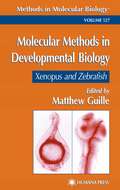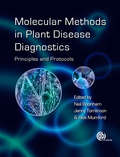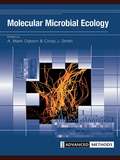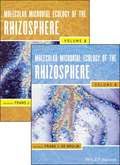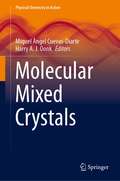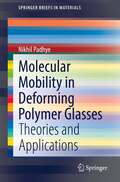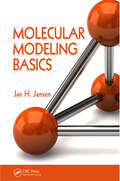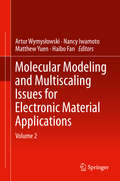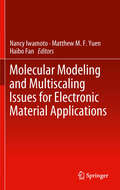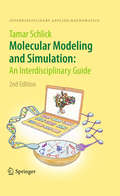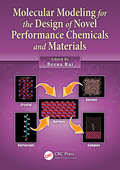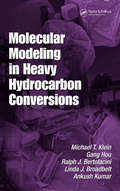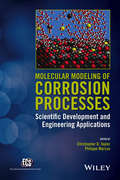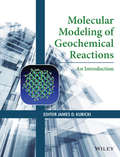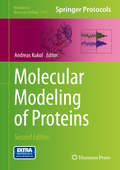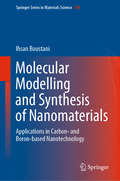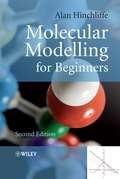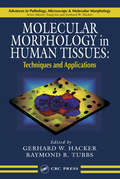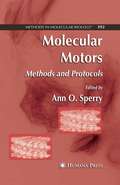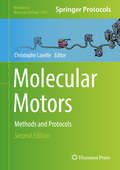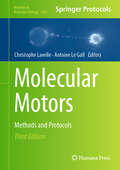- Table View
- List View
Molecular Methods in Developmental Biology
by Matt GuilleMatthew Guille assembles a hands-on collection of basic and essential molecular and embryological techniques for studying Xenopus and zebrafish. Easily reproducible and designed to succeed, these detailed methods include cellular techniques, techniques for the quantitative and spatial analysis of mRNA and proteins, and techniques for the expression of gene products in embryos. More specialized methods enable users to analyze promoters and transcription factors during early development, and include gel shift assays, as well as in vitro and in vivo footprinting. Molecular Methods in Developmental Biology: Xenopus and Zebrafish affords newcomers rapid access to a wide variety of essential, state-of-the-art techniques in developmental studies, and offers experienced researchers time-saving tips and new techniques from experts who have fine-tuned them for best results.
Molecular Methods in Plant Disease Diagnostics: Principles and Protocols
by Jennifer Hodgetts Jenny Tomlinson James Woodhall Susan Seal Maja Ravnikar Rick Mumford Adrian Fox Neil Boonham Juerg Frey Ian Adams Bart van de Vossenberg Rachel GloverUsing molecular methods for plant disease diagnosis provides diagnosticians with a number of advantages over more traditional methods. They can allow the identification of morphologically similar species, for example, or the detection of infection prior to symptom formation. Not only can molecular tools help by increasing the efficacy, accuracy and speed of diagnosis; their common technological basis provides further benefits, especially where resources are limited and traditional skills are hard to sustain. This book provides protocols for nucleic acid-based methods currently applied to plant pathogen detection and identification. It takes the practitioner through the full range of molecular diagnostic and detection methods and, as these generic techniques are appropriate for use on any target with minimal modification, also provides a useful resource for students of plant pathology and plant pathologists. Beginning with the background and future directions of the science, it then addresses DNA barcoding, microarrays, polymerase chain reactions (PCR), quality assurance and more, forming a complete reference on the subject.
Molecular Methods in Plant Disease Diagnostics: Principles and Protocols
by Jennifer Hodgetts James Woodhall Susan Seal Maja Ravnikar Adrian Fox Juerg Frey Ian Adams Bart van de Vossenberg Rachel GloverUsing molecular methods for plant disease diagnosis provides diagnosticians with a number of advantages over more traditional methods. They can allow the identification of morphologically similar species, for example, or the detection of infection prior to symptom formation. Not only can molecular tools help by increasing the efficacy, accuracy and speed of diagnosis; their common technological basis provides further benefits, especially where resources are limited and traditional skills are hard to sustain. This book provides protocols for nucleic acid-based methods currently applied to plant pathogen detection and identification. It takes the practitioner through the full range of molecular diagnostic and detection methods and, as these generic techniques are appropriate for use on any target with minimal modification, also provides a useful resource for students of plant pathology and plant pathologists. Beginning with the background and future directions of the science, it then addresses DNA barcoding, microarrays, polymerase chain reactions (PCR), quality assurance and more, forming a complete reference on the subject.
Molecular Methods in Plant Pathology
by Rudra P. Singh Uma. S. SinghMolecular Methods in Plant Pathology covers methods in phytopathology at the molecular level, including PCR techniques, electron microscopy, tissue culturing, and the cloning of disease-resistant genes. Phytopathologists, botanists, horticulturists, and anyone working in agriculture will find this a useful reference on biophysical, biochemical, biomolecular, and biotechnological methods.
Molecular Microbial Ecology (Advanced Methods)
by Cindy J. Smith A. Mark OsbornMicrooganisms are distributed across every ecosystem, and microbial transformations are fundamental to the operation of the biosphere. Microbial ecology is the study of this interaction between microorganisms and their environment, and arguably represents one of the most important areas of biological research. Yet for many years our study of microbial flora was severely limited: the primary method of culturing microorganisms on media allowed us to study only between 0.1 and 10% of the total microbial flora in any given environment. Molecular Microbial Ecology gives a comprehensive guide to the recent revolution in the study of microorganisms in the environment. Details are given on molecular methods for isolating some of the previously uncultured and numerically dominant microbial groups. PCR-based approaches to studying prokaryotic systematics are described, including ribosomal RNA analysis and stable isotope probing. Later chapters cover DNA hybridisation techniques (including fluorescent in situ hybridisation), as well as genomic and metagenomic approaches to microbial ecology. Gathering together some of the world’s leading experts, this book provides an invaluable introduction to the modern theory and molecular methods used in studying microbial ecology.
Molecular Microbial Ecology of the Rhizosphere, Two Volume Set
by Frans J. de BruijnMolecular Microbial Ecology of the Rhizosphere covers current knowledge on the molecular basis of plant-microbe interactions in the rhizosphere. Also included in the book are both reviews and research-based chapters describing experimental materials and methods. Edited by a leader in the field, with contributions from authors around the world, Molecular Microbial Ecology of the Rhizosphere brings together the most up-to-date research in this expanding area, and will be a valuable resource for molecular microbiologists and plant soil scientists, as well as upper level students in microbiology, ecology, and agriculture.
Molecular Microbiology: Diagnostic Principles and Practice (ASM Books #51)
by Et. Al. David H. Persing Fred C. TenoverPresenting the latest molecular diagnostic techniques in one comprehensive volume The molecular diagnostics landscape has changed dramatically since the last edition of Molecular Microbiology: Diagnostic Principles and Practice in 2011. With the spread of molecular testing and the development of new technologies and their opportunities, laboratory professionals and physicians more than ever need a resource to help them navigate this rapidly evolving field. Editors David Persing and Fred Tenover have brought together a team of experienced researchers and diagnosticians to update this third edition comprehensively, to present the latest developments in molecular diagnostics in the support of clinical care and of basic and clinical research, including next-generation sequencing and whole-genome analysis. These updates are provided in an easy-to-read format and supported by a broad range of practical advice, such as determining the appropriate type and quantity of a specimen, releasing and concentrating the targets, and eliminating inhibitors. Molecular Microbiology: Diagnostic Principles and Practice Presents the latest basic scientific theory underlying molecular diagnostics Offers tested and proven applications of molecular diagnostics for the diagnosis of infectious diseases, including point-of-care testing Illustrates and summarizes key concepts and techniques with detailed figures and tables Discusses emerging technologies, including the use of molecular typing methods for real-time tracking of infectious outbreaks and antibiotic resistance Advises on the latest quality control and quality assurance measures Explores the increasing opportunities and capabilities of information technology Molecular Microbiology: Diagnostic Principles and Practice is a textbook for molecular diagnostics courses that can also be used by anyone involved with diagnostic test selection and interpretation. It is also a useful reference for laboratories and as a continuing education resource for physicians.
Molecular Mixed Crystals (Physical Chemistry in Action)
by Miquel Àngel Cuevas-Diarte Harry A.J. OonkThis book focuses on mixed crystals formed by molecular substances. The emphasis lies on the elucidation of the structural and thermodynamic properties of two-component systems. Thanks to the fact that the research efforts have been directed to a number of families of chemically coherent substances, rather than to a collection of isolated systems, the knowledge of mixed crystals has substantially increased. This is reflected by the discovery of several empirical relationships between thermodynamic properties, crystallographic properties, and also between thermodynamic mixing properties and exothermodynamic parameters, such as the structural mismatch between the components of the binary systems. This book is a benchmark for material scientists and a unique starting point for anyone interested in mixed crystals.
Molecular Mobility in Deforming Polymer Glasses: Theories and Applications (SpringerBriefs in Materials)
by Nikhil PadhyeThis book bridges disparate fields in an exploration of the phenomena and applications surrounding molecular mobility in glassy materials experiencing inelastic deformation. The subjects of plastic deformation and polymer motion/interdiffusion currently belong to the two different fields of continuum mechanics and polymer physics, respectively. However, molecular motion associated with plastic deformation is a key ingredient to gain fundamental understanding, both at the macroscopic and microscopic level. This short monograph provides necessary background in the aforementioned fields before addressing the topic of molecular mobility accompanied by macroscopic inelastic deformation in an accessible and easy-to-understand manner. A new phenomenon of solid-state deformation-induced bonding in polymers is discussed in detail, along with some broad implications in several manufacturing sectors. Open questions pertaining to mechanisms, mechanics, and modeling of deformation-induced bonding in polymers are presented. The book’s clear language and careful explanations will speak to readers of diverse backgrounds.
Molecular Modeling Basics
by Jan H. JensenMolecular modeling is becoming an increasingly important part of chemical research and education as computers become faster and programs become easier to use. The results, however, have not become easier to understand. Addressing the need for a "workshop-oriented" book, Molecular Modeling Basics provides the fundamental theory needed to understand
Molecular Modeling and Multiscaling Issues for Electronic Material Applications
by Nancy Iwamoto Haibo Fan Artur Wymyslowski Matthew YuenThis book offers readers a snapshot of the progression of molecular modeling in the electronics industry and how molecular modeling is currently being used to understand materials to solve relevant issues in this field. The reader is introduced to the evolving role of molecular modeling, especially seen from the perspective of the IEEE community and modeling in electronics. This book also covers the aspects of molecular modeling needed to understand the relationship between structures and mechanical performance of materials. The authors also discuss the transitional topic of multiscale modeling and recent developments on the atomistic scale and current attempts to reach the submicron scale, as well as the role that quantum mechanics can play in performance prediction.
Molecular Modeling and Multiscaling Issues for Electronic Material Applications
by Nancy Iwamoto Matthew M.F. Yuen Haibo FanMolecular Modeling and Multiscaling Issues for Electronic Material Applications provides a snapshot on the progression of molecular modeling in the electronics industry and how molecular modeling is currently being used to understand material performance to solve relevant issues in this field. This book is intended to introduce the reader to the evolving role of molecular modeling, especially seen through the eyes of the IEEE community involved in material modeling for electronic applications. Part I presents the role that quantum mechanics can play in performance prediction, such as properties dependent upon electronic structure, but also shows examples how molecular models may be used in performance diagnostics, especially when chemistry is part of the performance issue. Part II gives examples of large-scale atomistic methods in material failure and shows several examples of transitioning between grain boundary simulations (on the atomistic level)and large-scale models including an example of the use of quasi-continuum methods that are being used to address multiscaling issues. Part III is a more specific look at molecular dynamics in the determination of the thermal conductivity of carbon-nanotubes. Part IV covers the many aspects of molecular modeling needed to understand the relationship between the molecular structure and mechanical performance of materials. Finally, Part V discusses the transitional topic of multiscale modeling and recent developments to reach the submicronscale using mesoscale models, including examples of direct scaling and parameterization from the atomistic to the coarse-grained particle level.
Molecular Modeling and Simulation: An Interdisciplinary Guide
by Tamar SchlickVery broad overview of the field intended for an interdisciplinary audience; Lively discussion of current challenges written in a colloquial style; Author is a rising star in this discipline; Suitably accessible for beginners and suitably rigorous for experts; Features extensive four-color illustrations; Appendices featuring homework assignments and reading lists complement the material in the main text
Molecular Modeling at the Atomic Scale: Methods and Applications in Quantitative Biology (Series in Computational Biophysics)
by Ruhong ZhouAlthough molecular modeling has been around for a while, the groundbreaking advancement of massively parallel supercomputers and novel algorithms for parallelization is shaping this field into an exciting new area. Developments in molecular modeling from experimental and computational techniques have enabled a wide range of biological applications.
Molecular Modeling for the Design of Novel Performance Chemicals and Materials
by Beena RaiMolecular modeling (MM) tools offer significant benefits in the design of industrial chemical plants and material processing operations. While the role of MM in biological fields is well established, in most cases MM works as an accessory in novel products/materials development rather than a tool for direct innovation. As a result, MM engineers and
Molecular Modeling in Heavy Hydrocarbon Conversions (Chemical Industries)
by Michael T. Klein Gang Hou Ralph Bertolacini Linda J. Broadbelt Ankush KumarIn the past two decades, new modeling efforts have gradually incorporated more molecular and structural detail in response to environmental and technical interests. Molecular Modeling in Heavy Hydrocarbon Conversions introduces a systematic molecule-based modeling approach with a system of chemical engineering software tools that can automate the e
Molecular Modeling of Corrosion Processes
by Philippe Marcus Christopher D. TaylorPresents opportunities for making significant improvements in preventing harmful effects that can be caused by corrosion Describes concepts of molecular modeling in the context of materials corrosion Includes recent examples of applications of molecular modeling to corrosion phenomena throughout the text Details how molecular modeling can give insights into the multitude of interconnected and complex processes that comprise the corrosion of metals Covered applications include diffusion and electron transfer at metal/electrolyte interfaces, Monte Carlo simulations of corrosion, corrosion inhibition, interrogating surface chemistry, and properties of passive films Presents current challenges and likely developments in this field for the future
Molecular Modeling of Geochemical Reactions: An Introduction
by James D. KubickiMolecular processes in nature affect human health, the availability of resources and the Earth's climate. Molecular modelling is a powerful and versatile toolbox that complements experimental data and provides insights where direct observation is not currently possible. Molecular Modeling of Geochemical Reactions: An Introduction applies computational chemistry to geochemical problems. Chapters focus on geochemical applications in aqueous, petroleum, organic, environmental, bio- and isotope geochemistry, covering the fundamental theory, practical guidance on applying techniques, and extensive literature reviews in numerous geochemical sub-disciplines. Topics covered include:* Theory and Methods of Computational Chemistry* Force Field Application and Development * Computational Spectroscopy * Thermodynamics* Structure Determination * Geochemical Kinetics This book will be of interest to graduate students and researchers looking to understand geochemical processes on a molecular level. Novice practitioners of molecular modelling, experienced computational chemists, and experimentalists seeking to understand this field will all find information and knowledge of use in their research.
Molecular Modeling of Proteins
by Andreas KukolMolecular modeling has undergone a remarkable transformation in the last 20 years. This book provides thorough introductions and a compilation of step-by-step methods applicable to problems faced by non-specialists - especially those new to the software packages used in molecular modeling. Tips on troubleshooting and avoiding common pitfalls are included in the book, along with chapters covering a wide range of subjects. Links to downloadable software are also provided.
Molecular Modelling and Synthesis of Nanomaterials: Applications in Carbon- and Boron-based Nanotechnology (Springer Series in Materials Science #290)
by Ihsan BoustaniThis book presents nanomaterials as predicted by computational modelling and numerical simulation tools, and confirmed by modern experimental techniques. It begins by summarizing basic theoretical methods, then giving both a theoretical and experimental treatment of how alkali metal clusters develop into nanostructures, as influenced by the cluster's "magic number" of atoms. The book continues with a discussion of atomic clusters and nanostructures, focusing primarily on boron and carbon, exploring, in detail, the one-, two-, and three-dimensional structures of boron and carbon, and describing their myriad potential applications in nanotechnology, from nanocoating and nanosensing to nanobatteries with high borophene capacity. The broad discussion of computational modelling as well as the specific applications to boron and carbon, make this book an essential reference resource for materials scientists in this field of research.
Molecular Modelling for Beginners
by Alan HinchliffeA concise, basic introduction to modelling and computational chemistry which focuses on the essentials, including MM, MC, and MD, along with a chapter devoted to QSAR and Discovery Chemistry.Includes supporting website featuring background information, full colour illustrations, questions and answers tied into the text,Visual Basic packages and many realistic examples with solutionsTakes a hands-on approach, using state of the art software packages G03/W and/or Hyperchem, Gaussian .gjf files and sample outputs.Revised with changes in emphasis and presentation to appeal to the modern student.
Molecular Morphology in Human Tissues: Techniques and Applications (Advances in Pathology, Microscopy, & Molecular Morphology)
by Gerhard W. Hacker Raymond R. TubbsMolecular Morphology in Human Tissues: Techniques and Applications presents the most advanced molecular morphological techniques to date. This integrated approach to molecular morphology provides powerful analytical and diagnostic tools at the genome level, making the diagnosis and management of cancer, viral infections, and other diseases more pre
Molecular Motors
by Ann O. SperryMolecular motor proteins produce force for movement in an incredibly wide variety of cellular processes. This volume explores the extreme functional and structural diversity of molecular motors and presents methods relevant to each motor family. In addition, it describes techniques directed at motors that fall outside of the three characterized families: dynamin and F1ATPase.
Molecular Motors: Methods and Protocols (Methods in Molecular Biology #1805)
by Christophe LavelleThis volume expands on the previous edition with a more extensive look at molecular motors and their roles in muscle contractions, vesicle transport, flagellar beating, chromosome segregation, and DNA replication and repair. The chapters in this book are divided into three parts: Part One looks at membrane motors, such as the bacterial flagellar rotary motor; Part Two discusses cytoskeletal motors, such as kinesin and myosin; and Part Three talks about nucleic acid motors, such as DNA polymerases, helicases, and nucleosome remodelers. Written in the highly successful Methods in Molecular Biology series format, chapters include introductions to their respective topics, lists of the necessary materials and reagents, step-by-step, readily reproducible laboratory protocols, and tips on troubleshooting and avoiding known pitfalls.Cutting-edge and comprehensive, Molecular Motors: Methods and Protocols, Second Edition is a valuable resource for (bio)physicists and molecular/cellular biologists whose research delves into the mechanisms at work in cells and the motors which power them.
Molecular Motors: Methods and Protocols (Methods in Molecular Biology #2881)
by Christophe Lavelle Antoine Le GallThis fully updated volume presents a diverse collection of protocols and methodologies for studying various molecular motors. The book explores the dynamics of the bacterial flagellar motor, the mechanisms of ATP synthase, the assembly and function of cytoskeletal motors, and the role of nucleic acid motors in cellular processes, while placing a strong emphasis on state-of-the-art techniques, highlighting innovative methods such as single-molecule visualization and high-resolution tracking, sophisticated biochemical assays, bioengineering applications, as well as computational modeling. Written for the highly successful Methods in Molecular Biology series, chapters include introductions to their respective topics, lists of the necessary materials and reagents, step-by-step and readily reproducible laboratory protocols, and tips on troubleshooting and avoiding known pitfalls. Authoritative and practical, Molecular Motors: Methods and Protocols, Third Edition serves as an ideal guide to enable researchers to probe the mechanisms of molecular motors with unprecedented precision and detail.
